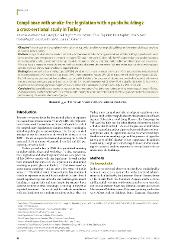| dc.contributor.author | Navas-Acien, Ana | |
| dc.contributor.author | Çarkoğlu, Aslı | |
| dc.contributor.author | Ergör, Gül | |
| dc.contributor.author | Hayran, Mutlu | |
| dc.contributor.author | Ergüder, Toker | |
| dc.contributor.author | Kaplan, Bekir | |
| dc.contributor.author | Susan, Jolie | |
| dc.contributor.author | Magid, Hoda | |
| dc.contributor.author | Pollak, Jonathan | |
| dc.contributor.author | Cohen, Joanna E. | |
| dc.date.accessioned | 2019-06-27T08:01:51Z | |
| dc.date.available | 2019-06-27T08:01:51Z | |
| dc.date.issued | 2016 | |
| dc.identifier.issn | 0042-9686 | en_US |
| dc.identifier.issn | 1564-0604 | en_US |
| dc.identifier.uri | https://hdl.handle.net/20.500.12469/485 | |
| dc.identifier.uri | https://doi.org/10.2471/BLT.15.158238 | |
| dc.description.abstract | ObjectiveTo investigate public compliance with legislation to prohibit smoking within public buildings and the extent of tobacco smoking in outdoor areas in Turkey. Methods Using a standardized observation protocol we determined whether smoking occurred and whether ashtrays cigarette butts and/or no-smoking signs were present in a random selection of 884 public venues in 12 cities in Turkey. We visited indoor and outdoor locations in bars/nightclubs cafes government buildings hospitals restaurants schools shopping malls traditional coffee houses and universities. We used logistic regression models to determine the association between the presence of ashtrays or the absence of no-smoking signs and the presence of individuals smoking or cigarette butts. Findings Most venues had no-smoking signs (629/884). We observed at least one person smoking in 145 venues most frequently observed in bars/nightclubs (63/79) hospital dining areas (18/79) traditional coffee houses (27/120) and government-building dining areas (5/23). For 538 venues we observed outdoor smoking close to public buildings. The presence of ashtrays was positively associated with indoor smoking and cigarette butts adjusted odds ratio aOR: 315.9 | en_US] |
| dc.description.abstract | 95% confidence interval CI: 174.9-570.8 and aOR: 165.4 | en_US] |
| dc.description.abstract | 95% CI: 98.0-279.1 respectively. No-smoking signs were negatively associated with the presence of cigarette butts aOR: 0.5 | en_US] |
| dc.description.abstract | 95% CI: 0.3-0.8. Conclusion Additional efforts are needed to improve the implementation of legislation prohibiting smoking in indoor public areas in Turkey especially in areas in which we frequently observed people smoking. Possible interventions include removing all ashtrays from public places and increasing the number of no-smoking signs. | en_US] |
| dc.language.iso | eng | en_US |
| dc.publisher | World Health Organization | en_US |
| dc.rights | info:eu-repo/semantics/openAccess | en_US |
| dc.subject | N/A | en_US |
| dc.title | Compliance with Smoke-Free Legislation Within Public Buildings: a Cross-Sectional Study in Turkey | en_US |
| dc.type | article | en_US |
| dc.identifier.startpage | 92 | en_US |
| dc.identifier.endpage | 102 | |
| dc.relation.journal | Bulletin of the World Health Organization | en_US |
| dc.identifier.issue | 2 | |
| dc.identifier.volume | 94 | en_US |
| dc.department | Fakülteler, İktisadi, İdari ve Sosyal Bilimler Fakültesi, Psikoloji Bölümü | en_US |
| dc.identifier.wos | WOS:000372674200006 | en_US |
| dc.identifier.doi | 10.2471/BLT.15.158238 | en_US |
| dc.identifier.scopus | 2-s2.0-84957606623 | en_US |
| dc.institutionauthor | Çarkoğlu, Aslı | en_US |
| dc.relation.publicationcategory | Makale - Uluslararası Hakemli Dergi - Kurum Öğretim Elemanı | en_US |
| dc.identifier.pmid | 26908959 | en_US |
















